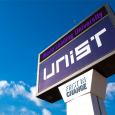A novel technology that utilizes light of different wavelengths to control cellular functions by inducing reversible assembly and disassembly of molecules has been developed. This breakthrough could pave the way for new approaches in treating superficial cancers, such as skin cancer, as well as serving as a powerful molecular tool for fundamental life science investigations.
A research team, led by Professor Ryu Ja-Hyoung in the Department of Chemistry at UNIST, announced the development of a photoswitchable molecule named ‘Mito-AZB,’ capable of repeatedly assembling and disassembling in response to specific light wavelengths.
This molecule specifically targets mitochondria within cells and exerts controlled mechanical stress on mitochondrial membranes through repeated cycles of assembly and disassembly. When exposed to visible light at 450 nm, the molecules assemble into a robust fibrous structure, applying physical stress to the mitochondrial membrane. Conversely, upon irradiation with ultraviolet light at 350 nm, the fibers disassemble. This cyclical process damages the mitochondrial membrane, causing the release of pro-apoptotic factors into the cytoplasm and ultimately inducing apoptosis, a form of programmed cell death.
Experimental results demonstrated that, following treatment with the molecule and alternating exposure to UV and visible light, mitochondrial membrane potential collapsed, and levels of reactive oxygen species and apoptosis-related proteins surged within cells. Fluorescence microscopy confirmed the accumulation of the molecules around mitochondria, validating their targeted action.
The development of Mito-AZB involved combining three key components: a targeting moiety that guides the molecule to mitochondria, an azobenzene unit that undergoes reversible structural changes upon light irradiation, and a fluorescent dye for real-time visualization under microscopy. By replacing the mitochondrial targeting component with other organelle-specific molecules, the team successfully adapted the system to target lysosomes and the endoplasmic reticulum, demonstrating its versatility in selectively disrupting various cellular organelles.
Professor Ryu explained, “This research demonstrates that external light stimuli can precisely manipulate molecular assembly states within cells and modulate cellular responses accordingly.” He further noted, “Such technology holds promise for treating superficial cancers like skin cancer through targeted, non-invasive light therapy. Furthermore, it provides a powerful molecular tool for basic research to transiently inhibit or activate organelle functions, advancing our understanding of cellular mechanisms.”
The findings of this research have been published in Nano Letters on October 8, 2025. It has been supported by the Ministry of Science and ICT (MSIT) and the National Research Foundation (NRF) of Korea.
Journal Reference
Sangpil Kim, Dohyun Kim, Youngji Jo, et al., “Photoregulated Assembly–Disassembly Dynamics of Interfering with Organelle Membrane Integrity,” Nano Lett., (2025).












